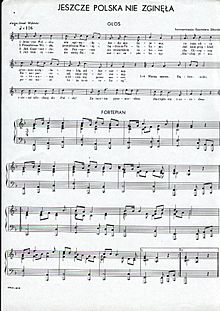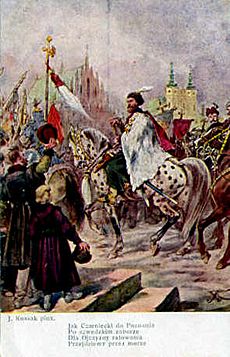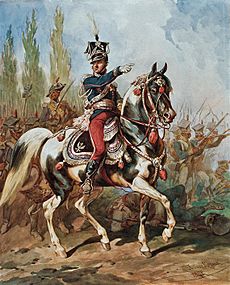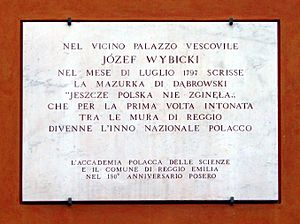Poland Is Not Yet Lost facts for kids
 |
|
| National anthem of | Poland |
|---|---|
| Also known as | "Pieśń Legionów Polskich we Włoszech" English: "Song of the Polish Legions in Italy" "Jeszcze Polska nie zginęła" English: "Poland Is Not Yet Lost" |
| Lyrics | Józef Wybicki, 1797 |
| Music | Composer unknown (arranged by Kazimierz Sikorski), 18th century |
| Adopted | 1927 |
"Poland Is Not Yet Lost" (in Polish: Jeszcze Polska nie zginęła), also known as "Mazurek Dąbrowskiego", is the national anthem of Poland. It's also called the "Song of the Polish Legions in Italy".
The words were written by Józef Wybicki in Italy in July 1797. This was two years after Poland had been divided up by other countries and disappeared from the map. The song was meant to cheer up the Polish Legions. These were Polish soldiers who fought with Napoleon Bonaparte's army in Italy. The song shared an important idea: even if Poland didn't have its own country, the Polish nation was still alive as long as its people lived and fought for it.
The music is a mazurka, a lively Polish folk dance tune. It's thought to be a popular melody that Wybicki adapted for his words. When Poland became an independent country again in 1918, "Mazurek Dąbrowskiego" became its national anthem. It was officially chosen in 1927. This song also inspired other countries fighting for their freedom in the 1800s. For example, it influenced the national anthems of Ukraine and the former Yugoslavia.
Contents
What's in a Name?
The anthem is also known by its first name, "Pieśń Legionów Polskich we Włoszech", which means "Song of the Polish Legions in Italy". Its most famous line, "Jeszcze Polska nie zginęła", can be translated in a few ways. Some common English meanings are "Poland has not yet perished" or "Poland is not yet lost".
The Words of the Anthem
The original words were a poem by Wybicki. It had six verses and a chorus that repeated. The main idea of the poem is that a nation can still exist even if it doesn't have its own independent country. This is true as long as its people are alive and keep their spirit.
The song also calls people to fight. It expresses hope that the Polish soldiers, led by General Jan Henryk Dąbrowski, would return to Poland. They hoped to take back what foreign powers had taken from them.

The chorus and verses mention brave military heroes. These heroes were role models for the Polish soldiers. They include Jan Henryk Dąbrowski, Napoleon, Stefan Czarniecki, and Tadeusz Kościuszko. Dąbrowski, who the anthem is named after, was a leader in a Polish uprising against Russia in 1794. After Poland was divided, he went to France to ask for help. In 1796, he started forming the Polish Legions.
Napoleon Bonaparte was the commander of the French army in Italy when the song was written. He was Dąbrowski's leader. The song says he "has shown us ways to victory." Napoleon is the only non-Polish person mentioned by name in the anthem.

Stefan Czarniecki was a Polish military leader from the 1600s. He was famous for helping to drive the Swedish army out of Poland. This event is known as the Deluge. He even fought the Swedes in Denmark and "returned across the sea" to help save his homeland.
Tadeusz Kościuszko was a hero of the American Revolutionary War. He later returned to Poland to defend his country from Russia. He led a national uprising in 1794. One of his big wins was the Battle of Racławice. In this battle, Polish peasants armed with scythes helped win. The song also mentions other traditional Polish weapons, like the sabre.
Basia (a girl's name) and her father are made-up characters in the song. They stand for the women and older men waiting for the soldiers to come home. The song also mentions the Vistula and Warta rivers. These are major rivers in Poland. Crossing them meant the legions would return to the parts of Poland taken by Austria and Prussia.
The Music
The music of the Polish anthem is a lively and rhythmic mazurka. A mazurka is a type of Polish folk dance music. It has a special rhythm with strong beats that don't always fall in the same place. This dance became very popular in Europe in the 1800s, partly thanks to the famous Polish composer Frédéric Chopin.
No one knows for sure who composed the melody of "Mazurek Dąbrowskiego". It was most likely a popular folk tune that Wybicki changed to fit his words. For a while, people thought Michał Kleofas Ogiński wrote it. But in 1938, his actual march for the legions was found, and it was different from the anthem.
Many composers have used the anthem's melody in their own music. Karol Kurpiński was one of the first, composing a piece for piano or organ in 1821. Later, composers like Richard Wagner and Edward Elgar also included parts of the anthem in their works.
The official musical version of the anthem used today was arranged by Kazimierz Sikorski. It allows the song to be sung without instruments or with a full orchestra.
Rules for the Anthem
The national anthem is one of Poland's three main national symbols. The others are the national coat of arms and the national colors. Polish law says that everyone in Poland must treat these symbols with respect.
The anthem should be played or sung during national holidays and special events. When the anthem is played, people should stand respectfully. Men should take off their hats. People in uniform should stand at attention. If they are not in a group, they should also salute. The anthem must be played in the key of F-major for public events.
How the Anthem Came to Be
Its Beginning

In 1795, Poland was divided up by its powerful neighbors: Russia, Prussia, and Austria. This meant Poland disappeared from the map. Many people thought this was the end of the Polish nation.
But Polish patriots and revolutionaries looked to France for help. France was fighting Austria at the time. Józef Wybicki was one of the leaders who wanted France to help Poland become independent again. In 1796, he suggested creating Polish Legions within the French army. He convinced General Jan Henryk Dąbrowski to go to Paris with this idea. Dąbrowski was then sent to Napoleon in Italy. In January 1797, a Polish legion was formed. Dąbrowski and his soldiers hoped to fight with Napoleon and then march "from Italy to Poland" to start an uprising.

In July 1797, Wybicki arrived in Reggio Emilia, Italy, where the Polish Legions were staying. He wrote the Song of the Polish Legions there. He first sang it to Polish officers. The first public performance was probably on July 16, 1797, during a military parade. It was played again on July 20 as the Legions marched to Milan.
The song quickly became popular among the Polish soldiers. Its inspiring words and folk melody appealed to everyone. Dąbrowski wrote to Wybicki that "soldiers gain more and more taste for your song." The last verse, which mentioned Kościuszko and the "scythes of Racławice," was especially popular with the peasant soldiers.
Growing Popularity
The song became popular in Poland by late 1797. It was changed and adapted over time. For example, the line "not dead" was changed to "not perished." New verses were also added, though many are now forgotten.
The Polish Legions didn't end up going back to Poland as the song hoped. Instead, they were used by the French in other places, like Haiti, where many died. But Polish hopes for freedom rose again in 1806 when France fought Prussia. Napoleon called Dąbrowski and Wybicki back from Italy to help gather support in Polish areas. When they arrived in Poznań, people sang "Poland Is Not Yet Lost" to greet them. This led to an uprising and the creation of a French-controlled Polish state called the Duchy of Warsaw.
"Poland Is Not Yet Lost" was one of the most popular patriotic songs in the Duchy of Warsaw. It was sung at celebrations and important events. The melody stayed the same, but the words sometimes changed. For example, a verse mentioning Russians as enemies was removed when France and Russia became allies.
The anthem is mentioned twice in Pan Tadeusz, a famous Polish epic poem written in 1834. It describes a musical clock playing the "old Dąbrowski's Mazurka." Later, a Jewish musician plays the mazurka for General Dąbrowski himself. Musical boxes and clocks playing the anthem were popular patriotic items back then.
After Napoleon's defeat in 1815, Poland was under foreign rule for a century. But "Poland Is Not Yet Lost" continued to be sung during uprisings. During the November Uprising against Russia in 1830–1831, soldiers sang it on battlefields. In peaceful times, Poles sang it at home and at protests. Singing the anthem in public became risky in parts of Poland ruled by Russia and Prussia. German courts even gave out sentences for singing it.
Choosing the National Anthem
When Poland became independent after World War I in 1918, it needed to choose its national symbols. The coat of arms and flag were chosen quickly. But the national anthem took longer. Many other patriotic songs were also popular.
In the Middle Ages, hymns like Bogurodzica ("Mother of God") and Gaude Mater Polonia ("Rejoice, Mother Poland") served as national anthems. They were sung on special occasions and in battles. Later, during the Renaissance and Enlightenment, new songs were written to be national anthems, but they didn't become widely popular.
One important song was "Boże, coś Polskę" ("Lord! Who for so many ages enclosed Poland..."). It started as an official anthem under Russian rule. But its words changed over time to express hope for a free Poland. It is still sung in Polish churches today.
Other popular songs included "Warszawianka" (a song praising Polish rebels) and "Rota" ("The Oath"), which protested against German oppression.
In 1945, at the start of the United Nations, Poland was not invited. The famous Polish pianist Artur Rubinstein was performing the opening concert. He was very upset that Poland was not there. He played "Poland Is Not Yet Lost" loudly and slowly. The audience stood up and gave him a huge applause. This showed that "Poland was not lost yet."
Influence on Other Countries
"Poland Is Not Yet Lost" became a revolutionary song across Europe during the Revolutions of 1848. It inspired the Slovak poet Samo Tomášik to write "Hej, Sloveni" using the same melody. This song became the Pan-Slavic Anthem. During World War II, a version of this song became the national anthem of Yugoslavia. It was later used by Serbia and Montenegro. The similarity sometimes caused confusion during sports matches!
The line "Poland is not lost yet" has become a common saying in some languages, like German. It means "all is not lost." The Italian national anthem also mentions the partitions of Poland, showing the close ties between Italy and Poland.
Images for kids
See also
 In Spanish: Himno nacional de Polonia para niños
In Spanish: Himno nacional de Polonia para niños






